How to pray in Islam? Is a question each Muslim interested to get a clear answer. Salah is the second of Islam’s five pillars, and it is the most important. Salah is required to be performed five times daily by all Muslims who have reached the age of puberty, which is the age of legal accountability. It provides us with a chance to connect with Allah, to remember Him, and to express our thanks to Him, with the act of prostration serving as the point at which we are most intimate with Allah. On the Day of Judgment, Salah is considered a gift for every believer, and it is the first item for which we will be held accountable.
We’ve put up this quick tutorial to make it simple for novices to understand how it’s done, as well as anybody who wants to brush up on their skills. All of the decisions made in this section are in accordance with the Hanafi school of Islamic law.
During each day and night, there will be five designated periods for doing the Salah. Using an app or a website, you may quickly and simply determine the exact Salah times for your area.
How to pray in Islam: steps 1-5
Step 1: Ensure that you have made wudu and that you are wearing attire that, at the very least, covers your awrah when it is time for Salah. The awrah for males is to cover everything from the navel to the knees, including the hands and feet. Women are required to cover their whole body, with the exception of their hands, feet, and face.
Step 2: Find a clean place (such as on a prayer mat) and a location where you will not cause discomfort to others before you begin.
Step 3: Stand towards the Qiblah (the direction of the Ka’bah in Makkah), which is to the south-east in the UK.
There are several free applications that will tell you where the Qiblah is by utilising your phone’s compass. You may pray sitting down if you are unable to stand due to disease or disability.
Step 4: Begin by expressing your purpose for the Salah, either loudly or quietly.
This is done in Arabic or your native language.
‘I aim to pray the (four) Rak’at of Salaatul (Dhuhr) for Allah facing the Ka’bah,’ you say, substituting the sections in brackets with the right number of Rak’ats (units of prayer) and the Salah you’re going to do.
Step 5: Focus totally on Allah and praying to Him from the moment you make this intention until the finish of your Salah.
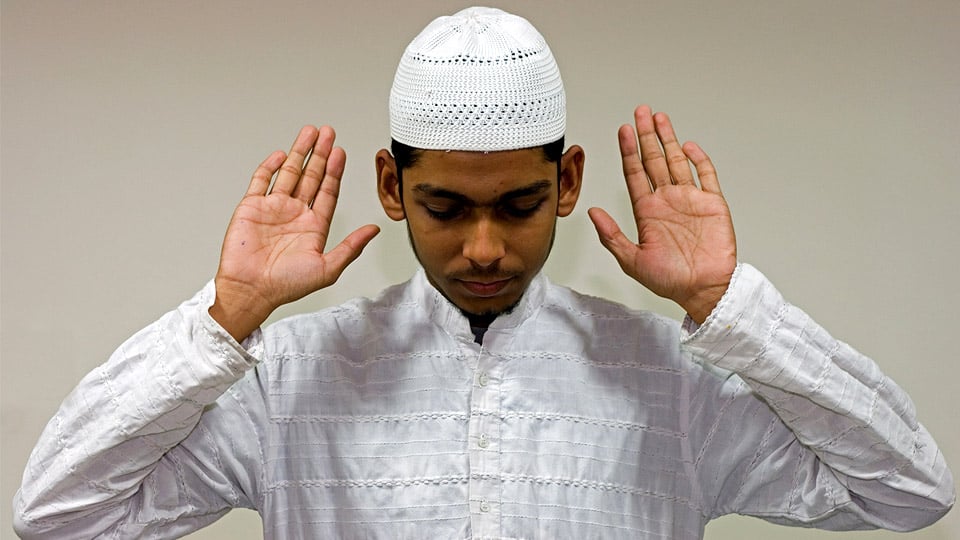
How to pray in Islam: steps 6-10
Step 6:Raise your hands to your earlobes for males and your shoulders for ladies while reciting ‘Allahu Akbar.’
This translates to ‘Allah is the Greatest.’
You are now in a state of ihram, which implies that any worldly activities, including as chatting, laughing, eating, drinking, or thinking about anything that would divert you, are banned.
Step 7:Placing your right hand just below your navel over your left is required.
Crossing one’s hands over one’s chest is appropriate for women.
Step 8:’SubhanaK-Allahumma wa bihamdiKa, wa tabaarak-asmuKa, wa ta-‘aala jadduKa, wa la ilaaha ghayruK,’ say gently.
‘O Allah, honour and praise are for You, and blessed is Your Name, and exalted is Your Majesty, and there is no deity but You,’ it says.
Step 9:Then silently recite, ‘Auudhu bi-Llahi min ash-Shaitaanir rajeem bismi-Llahir Rahmaani Rahm
This implies, ‘I want Allah’s protection against the rejected Satan.’
In the name of Allah, the Most Merciful and Gracious.’
Step 10:Recite Surah al-Fatihah, ending with a calm ‘Ameen,’ which means ‘let it be so.’
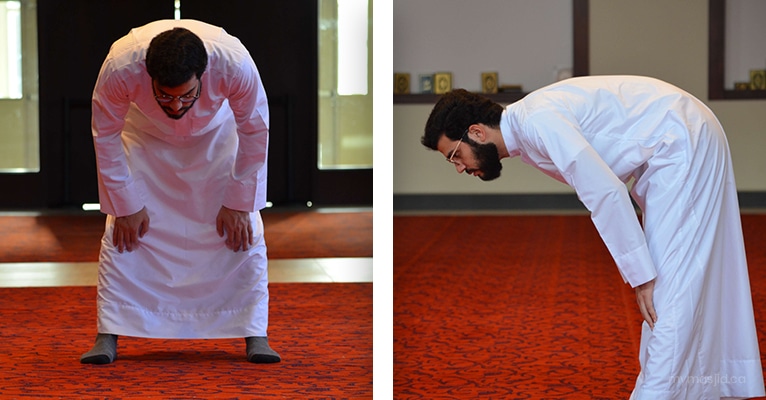
How to pray in Islam: steps 11-15
Step 11: The bare minimum is three verses, or one long verse that is comparable in length to three short ones, whichever is shorter.However, it is preferable to recite the whole Surah.
Step 12:Bow down and shout ‘Allahu Akbar,’ which means ‘Allah is Greatest,’ with your hands on your knees and your back straight. Rest in this posture, known as Ruku (bowing), and pronounce ‘Subhaana Rabbiy-al-Adheem’ at least three times.
This translates to ‘Glory to my Lord, the Great.’
Step 13:Then, when you stand up completely erect, say, ‘Sami-Allahu liman hamidaH’ – ‘Allah heard the one who thanked Him.’ Then say, ‘Rabbana laKal hamd,’ which means, ‘O our Lord, all praise is due to You.’
Step 14:Say ‘Allahu Akbar’ once again and go into Sujood, or prostration.
When prostrating, make sure that your forehead, nose, palms of both hands, knees, and toes are all pointed forward and contacting the floor.
Step 15:’Subhaana Rabbiy-al-Aalaa’ – ‘Glory be to my Lord, the Highest’ – at least three times.
Sit up and yell ‘Allahu Akbar.’
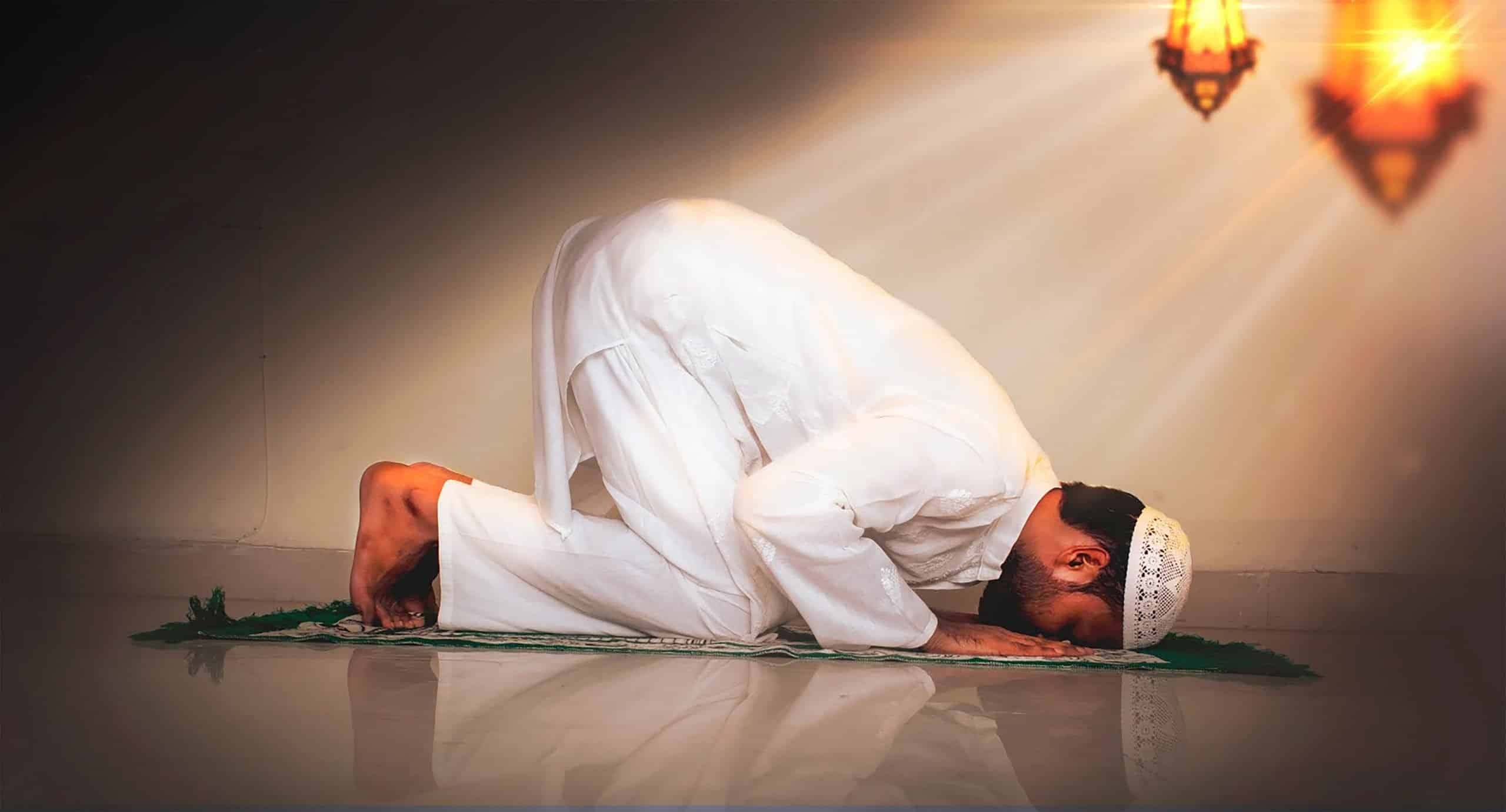
How to pray in Islam: steps 16-20
Step 16:Place your hands on your knees, palms up.
Sit on the flat of your left foot, with your right foot’s toes planted and pointed forward.
Women should lean on their left hip, pointing their toes to the right.
Step 17:Return to prostration after a few seconds, shouting ‘Allahu Akbar,’ and repeat step 15.
Step 18:Stand perfectly upright while repeating ‘Allahu Akbar.’ You have just finished your first Salah unit, or Rak’ah!
Step 19:Repeat steps 10 through 17.
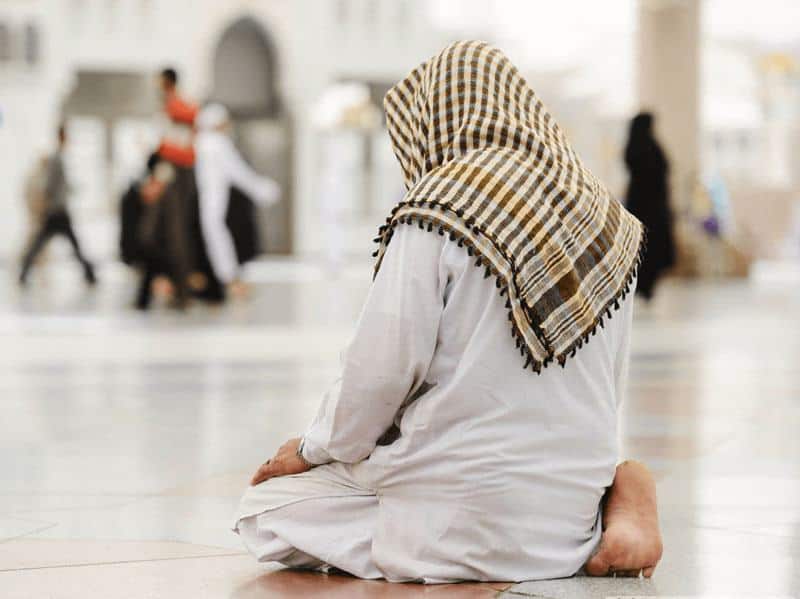
How to pray in Islam: steps 21-25
Step 20:Then, as mentioned in step 16, return to a sitting posture.
Step 21:Recite the first portion of the Tashaahud while sitting: ‘At-tahiyyatu lillah, was-salawaatu wat-tayyibaat.
As-salamu alayka ayyuhan-Nabiyyu wa rahmat-Ullahi wa barakaatu ‘As-salamu alayna, wa alaa ibaadi-llahis saaliheen.’
This implies, ‘All compliments, prayers, and kindness are for Allah.’
Peace be with you, O Prophet, as well as Allah’s kindness and blessings.
‘Peace be upon us and on Allah’s pious slaves.’
Step 22:Then, while maintaining your hands on your knees, lift your right index finger while clasping your right hand’s other fingers. Recite the second portion of the Tashaahud: ‘Ashhadu a laa ilaaha ill-Allahu wa ashhadu anna Muhammadan abduHu wa Rasooluh.’
This means, ‘I give testimony that there is no deity but Allah, and Muhammad is His servant and messenger.’
Step 23:Lower your right index finger so that your hands are once again resting on your knees.
Step 24:Please follow steps 25 to 28 if you are praying the two Rak’ats of the Fajr prayer.
If not, please go to step 29.
Step 25:Continue to sit and repeat, ‘Allahumma salli alaa Muhammadiw wa alaa aali Muhammadin, kamaa sallayta alaa Ibraheema wa alaa aali Ibraheema, innaKa Hameedum Majeed.’
Allahumma baarakta alaa Muhammadiw wa alaa aali Muhammadin, kamaa baarakta alaa Ibraheema wa alaa aali Ibraheema, innaKa Hameedum Majeed.
This means, ‘O Allah, bestow Your compassion onto Muhammad and his family, just as You sent mercy upon Ibrahim and his family.’
You are very praiseworthy and glorious.
O Allah, bestow blessings on Muhammad and his family, just as You bestowed blessings on Ibrahim and his family.
You are very praiseworthy and glorious.’
How to pray in Islam: steps 26-30
Step 26:It is therefore strongly advised to repeat certain supplications (du’a).
‘Rabbana aatina fid-dunya hasanataw wa fil-aakhirati hasantaw wa qina adhaaban Naar’ is a simple and comprehensive one.
‘O our Lord, give us good in this world and good in the next, and keep us away from the punishment of the Fire,’ the prayer reads in English.Step 27:The Salah is then completed by turning your head first over your right shoulder and uttering ‘As-salamu alaykum wa rahmat-Ullahi wa barakaatuH.’
Then, while looking over your left shoulder, repeat these sentences.
They signify, ‘May Allah’s peace, kindness, and blessings be upon you.’
Step 28:If you prayed Fajr, your Salah is now over!
Step 29:Steps 25 to 28 should not be performed if you are praying Dhuhr, Asr, Maghrib, or Ishaa.
Step 10 must be repeated, reciting Surah al-Fatihah while standing.
Step 30:Steps 12 through 17 must now be completed.
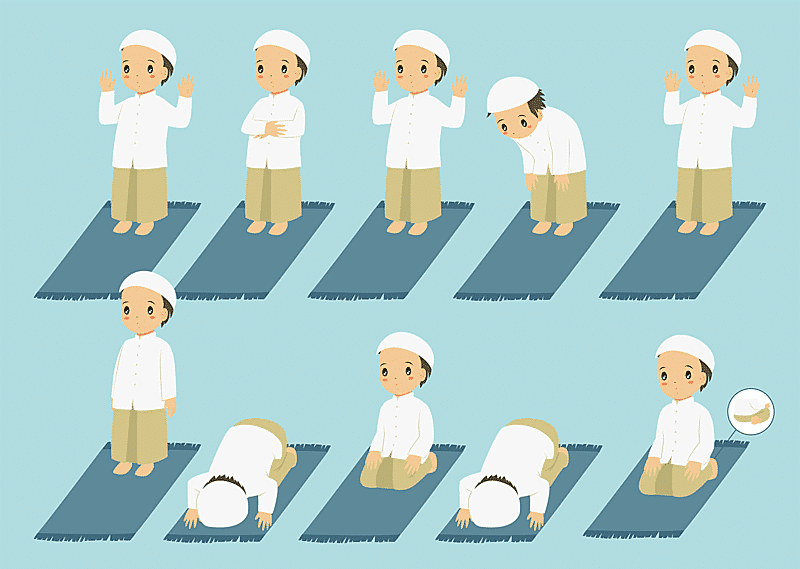
How to pray in Islam: steps 31-35
Step 31:Steps 20 to 23 must now be repeated if you are praying the three Rak’ah of Maghrib.
25–27 must then be repeated.
Your Maghrib request has already been fulfilled!
Step 32Please disregard step 31 if you are praying the four Rak’ah of Dhuhr, Asr, or Isha!
Steps 29 and 30 should be repeated instead.
Step 33Steps 20 through 23 must now be completed.
Then repeat steps 25–27.
Step 34You have now finished your Dhuhr, Asr, or Isha Salah!
All praise is due to Allah, Alhamdulillah!
Step 35For males praying in congregation, all of Fajr must be recited aloud.
Dhuhr and Asr must be performed quietly and under your breath.
The first two Rak’ahs of Maghrib and Ishaa should be read aloud, while the rest should be read silently.

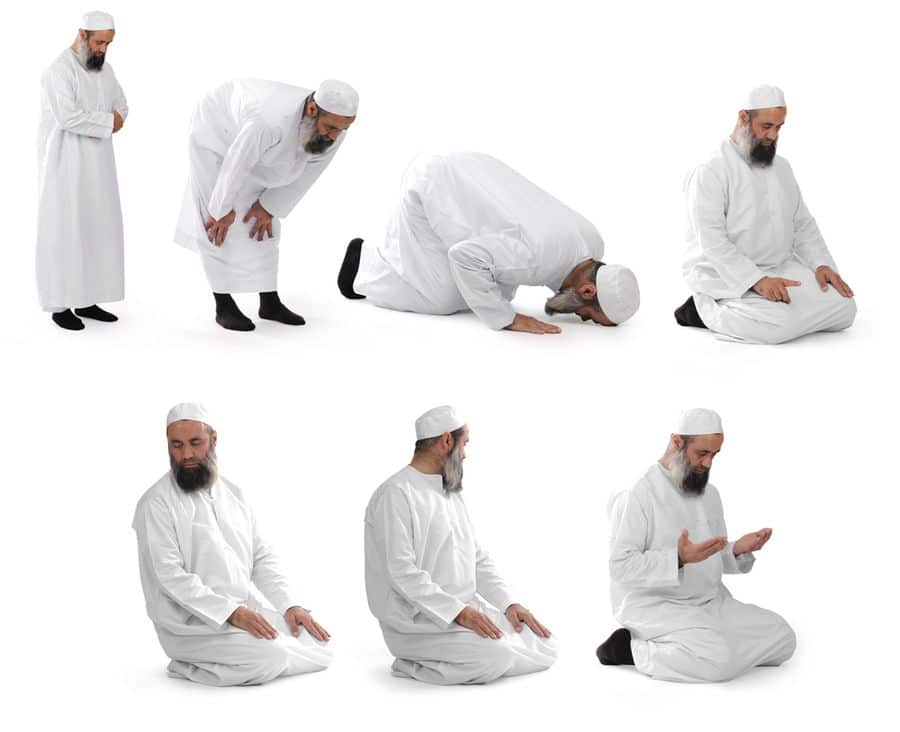


Pingback: hi